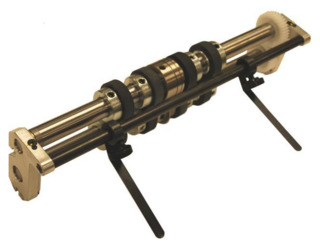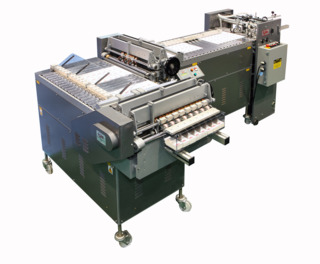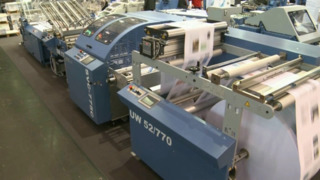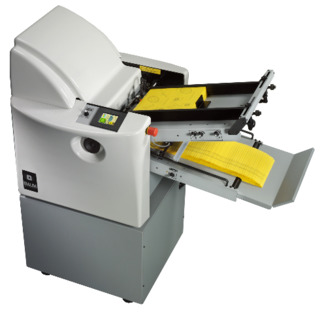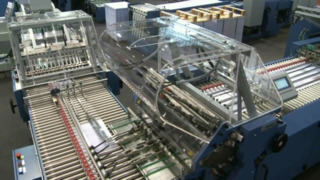Tailored, Swift: New Trends in Finishing
Finishing is often cited as the biggest production bottlenecks, but it doesn’t have to be.
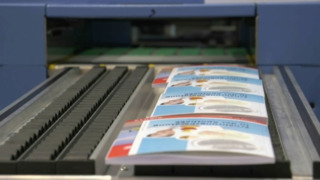
There has historically been a disconnect between printing and finishing equipment. Commercial printers didn’t always have their own in-house binding and finishing departments, so would send anything beyond cutting or folding to a trade bindery. Even those printers who did have in-house facilities tended to have the finishing equipment offline or nearline.
The acquisition of digital printing equipment has led many shops to bring more and more finishing processes in-house often because today’s demand for fast turnaround doesn’t allow for outsourcing. The need to bring finishing equipment inline with the print engine means speeds have to be equivalent, lest finishing create a bottleneck.
Speed isn’t the only trend in finishing today; the specific types of finishing processes that are becoming popular has been changing, and “automation” continues to be a strong driver in finishing, which is no easy feat in a class of machinery that has traditionally been very hands-on. And finishing systems need to be more closely tailored to a specific workflow than has been the case in the past.
Spin the Bottleneck
Finishing is often cited as the biggest production bottlenecks, but it doesn’t have to be.
“More often than not, finishing is an afterthought when it needs to be an important consideration,” said Ed Wong, Director of Product Marketing, Production Printing, for Ricoh. “Customers are so much more enamored with the feeds and speeds of the engine and little do they start thinking, until it’s too late, that you need a back end that doesn’t create a bottleneck.”
Most of the major finishing equipment manufacturers cut (and perfed and slit) their teeth in the heyday of offset, presses that ran faster than anything on the digital side, so why the mismatch?
“There are finishing solutions that match the speed and the automation of the printers,” said Si Nguyen, VP of Sales for Duplo. “The only time you have a mismatch is when the printer doesn’t have the budget to afford the right piece of equipment.”
Part of the problem is the installed base of legacy equipment, especially the glut of used equipment that appeared in the 2000s. “People are buying a used folder from 2005 or 2006 and making that work because it’s inexpensive,” said Lance Martin, Director of Sales for MBO.
Used equipment sounds like a bargain. But is it?
“I’ve seen people buying used equipment and trying to modify it, and I salute them for trying that,” said Mark Pellman, Director of Dealer Sales and Marketing for Baumfolder. “It’s just not as good as having a fully engineered solution that’s more productive, especially if you’re trying to run inline with a print engine.”
However, there is evidence that printers have started to see the virtue of newer finishing equipment. “That’s been something going on in the last quarter of 2014 and is continuing now,” said Martin.
In the context of digital printing, speed is not just about throughput. It’s also about job changeover.
“As run lengths become shorter, commercial printers are faced with the need for quicker finisher changeover from job to job,” said Henry Kremers, Finishing Manager, Graphic Communications, for Xerox. “This changeover needs to be in seconds to keep the shop productive, not minutes or hours. New finishing equipment is designed for fast changeover, but the cost is sometimes hard to justify when replacing existing equipment.”
Finishing equipment needs to accommodate shorter-run jobs. Take folding; to do automated, high-speed folding—say, a trifold on an 11 by 25.5-inch sheet—you would need a large floor model to handle this kind of work, but that may be impractical for short-run digital production. “People who have a Kodak Nexpress or some of the other digital print engines—even some of the Xerox engines—they want to do short-run full color and fold them,” said Pellman. “But the time to set up a larger folder may be more than the time to fold the stock.” Baumfolder has introduced an update to its Baum 714XA Autofold tabletop folder that can accommodate a 14 by 26-inch sheet.
That may not be the kind of thing one thinks about when investigating the purchase of a print engine. But it should be.
Specialty Finishing
In the past couple of years, as printers and their customers vie to create higher-end print products that stand out in mailboxes or elsewhere, specialty finishing processes have come to the fore. Scodix and MGI have made a big splash with their specialty finishing systems, but even traditional finishing is evolving in new directions.
“The trends that we’re seeing are for what we call specialty finishing,” said Nguyen. These include die-cutting, spot UV, varnishing, advanced cutting, and so on. “People are more interested in intricate cutting patterns, and the customer is asking for more shapes and patterns. The creativity is there.” Two years ago, Duplo introduced the UD-300 Rotary Die Cutter designed for short-run die-cutting applications. Duplo also has a full line of UV coaters.
Another process that’s growing in popularity is microperforating—adding tiny perfs for things like coupons, mail-in forms, and fundraising flyers. “A lot of printers found they can make margins on microperfing,” said Pellman. Baumfolder has introduced microperf kits for its line of tabletop folders.
Book production was one of the early applications for digital printing, and MBO’s Variable Book Block Production system gives printers the ability to finish different size books off the same printed roll. It can cut different length signatures, change fold paths on-the-fly, and mark variable page-count books at the delivery.
The Variable Book Block production system also takes advantage of automation via barcodes. “The folding machines are completely reacting to a barcode that is printed on the web,” said Martin. “You don’t have folding lengths to input into the machine; the machine is programmed with the sizes that are needed.”
Remote Control
Thus another finishing trend is automation. Automation has become a staple of prepress and printing, but tended to end at postpress. But that’s changing.
“Automation is the key to the digital print line,” said Xerox’s Kremers. “About eight years ago, we saw huge changes in the bindery with innovative companies like Horizon, Muller Martini, Hunkeler, Tecnau, and C.P. Bourg; these companies turned their products into fully automated devices. Today’s challenge is to create systems to integrate these with the needed workflows to really get the value out of them.”
Automated finishing systems have become plentiful, be they JDF- or simply barcode-based.
Like speed, automation can take many forms, and a basic one is trying to accomplish as many finishing processes at one time as possible. “You can take a sheet that used to perfed, cut, and glued,” said Doug Sherwood, National Sales Manager for Rollem. “Now you can take it to a station where you can do it all in one process.”
Duplo’s Nguyen sees more demand for multifunction products. “Slit/cut/crease is very high-demand equipment,” he said. As are the specialty finishing processes cited earlier. “Right now, die-cutting, embossing, spot UV, and tactile finishing are not really automated,” said Nguyen. “Those are still manual and if they are automated, they’re very expensive.” Expect that to change as demand increases.
There’s a renewed interest in what I call ‘bigger projects’ in direct mail,” said MBO’s Martin. “You don’t just go from a digital press to a sheet and then you handle it again to perforate it, and you handle it again to put it through a folder/gluer, handle it again to put it on a card affixer, and so on. A lot of projects now are inline rolls and sheets that are handling six, seven, eight different options down the line.”
One of the mantras in today’s print production workflow is “decrease touch points.” “Any time a product is moved from one station to another, you’re increasing the chance of something happening to it,” said Sherwood. Automation also helps alleviate the fact that it’s getting harder for shops to find experienced bindery workers, especially when it comes to things like die-cutting. “At least half of the operators who are running our equipment have never even seen a die-cutter and we’re able to train them in a day,” said Sherwood.
Baumfolder refers to on-the-machine training as “infomation.” “We have ‘infomated’ as much of our equipment as we can,” said Pellman. “We’ve put our ifold system on our floor-model feeders and folders so that anybody who walks up to that equipment can see how to set a job up. They have all kinds of tools at their fingertips that they don’t have on legacy equipment.”
When we think about automation, we automatically think of JDF. Indeed, many of the trade shows of yore were highly JDF-focused. Has it become the cure for all workflow ills?
“2004 was the JDF DRUPA and here we are, how many years later, and we’re still talking about it,” said Pellman. “It’s more prevalent in large production facilities than it is in the smaller ones. People don’t want to invest in it; they still don’t see the payback.”
Still, some level of JDF automation has been creeping in. Ricoh, Xerox, and HP—to name three digital press manufacturers—have been actively working on integrated JDF finishing. HP’s Direct2Finish and Xerox’s IntegratedPLUS Finishing Solution are two systems available for automating a workflow from prepress through finishing. What is the common denominator?
Enter Ultimate Bindery from Ultimate Technographics. The JDF-based Ultimate Bindery allows finishing parameters and specifications to be set as early as the prepress stage, and that information is included in the electronic job ticket information that is sent with the job through each stage of the production process. Finishing equipment is automatically configured, eliminating touch points.
Ricoh’s digital print and finishing solutions also leverage JDF. “Once a job gets to a print controller, that’s where all the commands are set for the finishing options that are done inline,” said Wong. “As jobs come through the JDF command, that’s going to trigger the finishing options.”
Automation is increasingly necessary not just to remove touch points, but to optimize production. “Automated imposition based on the finisher, batching like jobs by like finishing attributes, job splitting, and print order based on finishing are as important as the finisher,” said Kremers.
Customized Finishing
To reap all of these benefits, the print engine and the finishing need to tightly integrated. As a result, finishing systems are more and more customized to work with specific digital printing workflows. In the past, shops could get by with buying finishing equipment “off the rack”; today, one size does not fit all.
“When you buy a suit, you get a suit tailored to yourself,” said Sherwood. “There’s obviously a starting point, but what we like to do is more consulting. We can customize based on what their needs are.”
More and more digital press manufacturers are partnering with finishing equipment manufacturers to offer a complete solution, tailored to the customer’s individual needs. “This is the biggest reason we partner with Xerox and HP and bundle the equipment,” said Nguyen. “Instead of Duplo going out and selling our own piece of the solution, and Xerox going out and selling their piece of the solution, one source sells a printer and the finishing.”
The Finish Line
When buying a digital printing system, don’t just look at the print engine. Look at the entirety of what it is you’ll be producing, and buy as integrated a print/finishing system as possible. It may mean more outlays up front, but it will pay dividends down the road.
“The best way to learn about a finishing device and how it works is to make the time to go out and see one instead of just price shopping online,” said Nguyen.
“Make sure you’re considering every aspect of the system before you dive in,” said Wong.

